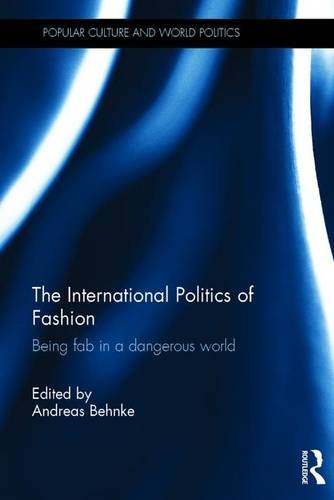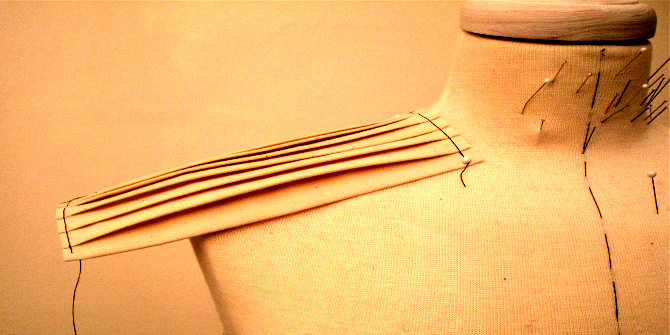The new collection The International Politics of Fashion: Being Fab in a Dangerous World, edited by Andreas Behnke, argues for the importance of fashion to understanding global politics, with a particular focus on its performative dimensions. In this review essay, I outline and builds upon the book’s intervention to propose a international politics of fashion as a set of political economic practices with profound, global implications.
Towards an International Politics of Fashion
When we look at the global political economy, our attention is often drawn to the practices of global corporations, especially across their supply chains. Problems in these often become newsworthy, and two industries are frequently the focus of attention: mobile telephony (e.g. the plight of workers building iPhones for Foxconn in China) and the garment trade (most obviously the death toll in the collapse of the Rana Plaza building in 2013).
That these supply chains are impacted by fashion seems obvious: the constant replacement of smart phones with the ‘must have’ latest model or the shift to fast fashion with the rise of Zara (and the resurgence of H&M), the latter of which has to some extent repatriated manufacturing into Europe’s periphery but has also required the swift delivery of garments elsewhere in manufacturing networks. Moreover, the business model of mass market retail fashion has started to shift how the up-market brands handle their marketing, with some moving from catwalk shows to more of a ‘fast fashion’ approach, dispensing with the show-to-retail seasonal delay. As one might imagine, this is having some impact on how production and distribution arrangements affect an already precarious workforce. Thus, thinking about fashion is not disconnected from political economy (or global politics more widely), and needs to be accorded similar attention as issues around changes in digital technologies in the analysis of the (supposed) information society and its workplace(s). However, this is not quite theinternational politics of fashion that is undertaken by the book under review here.
As editor Andreas Behnke notes in the introduction to The International Politics of Fashion: Being Fab in a Dangerous World, much of this volume revolves around the notion of (fashion’s) performativity, influenced by the work of Judith Butler. Here, performativity is seen as the manner in which identity is constructed for the self and the other through both conscious and unconscious choices about clothing. These ‘choices’ may be constrained or shaped by regulatory intervention and/or reflect social resistance, and for the contributors represent a site of political articulation and struggle. As such, they take a very specific view of what an international politics of fashion (IPF) might look like. Here, I want to firstly applaud and report on this development, but then, building on my introductory remarks, discuss what a broader IPF might look like. To be clear, this is a small volume and I appreciate entirely the need to be focused in such a project; but equally, I want to suggest a road towards an IPF that builds on the first step that Behnke’s volume makes. Essentially, I want to underline the key argument of this collection: fashion is not some frivolous marginal activity only of interest to cultural commentators, but rather is a set of political economic practices that have profound and important international dimensions.
The volume starts in earnest, following the editor’s scoping introduction, with Rosemary Shinko’s consideration of the body and its dress as a site both of the repetition and reproduction of social mores, but also where an alternate (oppositional) self can be constructed. Utilising the interplay between the mannequin and the lived experience of the consumer of dress via an engagement with the work of Michel Foucault, Shinko implicitly parallels some of the cultural arguments of the subcultural focus on dress from the 1970s/1980s: the revolt into style. Exploring both issues of dress as power as well as re-appropriation, Shinko is keen to stress fashion as a site of (possible) resistance that would be familiar to readers of Dick Hebdige’s analysis of the Mods. This link back to fashion and cultural studies is also explicitly made by Hazel Clark and Molly Rottman in their reflections on the book’s project in the final (short) chapter.
That the body is a site of resistance and regulation (sometimes but not always through sumptuary laws) has been emphasised recently by the banning of ‘Burkinis’ on the beach at some French resorts. This issue post-dates Marianne Franklin’s treatment of the veil, but amplifies a number of points she makes. Franklin points out that veiling and other forms of (so-called) ‘modest’ Muslim dress have been criminalised as part of a securitisation and anti-Muslim political discourse. Interestingly, while often presented implicitly as anti-fashion, Muslim dress for women has been already the subject of fashion: both reflecting the body as site of statement and performance of identity, but also in relation to the fashion industry’s response to market ‘demand’ – here, the ‘burkini’, imported from Australia, can be viewed as simply the latest fashion that seeks to mediate a perceived ‘otherness’ into mainstream culture while also establishing a new product line: a co-option of social mores by business?
This question of identity, clothing and sumptuary laws is explored with a much tighter focus in Linda Bishai’s account of the plight of Lubna Hussein, who was prosecuted in Sudan for wearing trousers. The case highlights both the manner in which legal instruments may be used to define what is acceptable dress and fashion, while also revealing the highly politicised zoning of enforcement around issues of class: in some locations frequented by the Sudanese elite, trousers raise little concern, but elsewhere, as Hussein found, they are subject to legal sanction, most obviously when they are worn by people the government wishes to control. Thus, Bishai uses her chapter to both explore the Hussein case and its aftermath in some detail, and to argue persuasively that such ‘crimes’ are always about more than the trousers.
Approaching this question from another direction, Mary Hope Schwoebel’s account of a quarter of a century of Somali women’s dress focuses not on external regulation, but rather on the way both coverage and colour have been deployed defensively by women in a highly unstable and potentially dangerous society. Here, fashion is driven not so much by style as by perceptions of its impact on viewers (although, of course, all fashion is a response to this perceived gaze of the other). In this account, the personal securitisation of clothing is a response to gendered violence and, as such, directly linked to the international political context of Somalia’s instability.
L.H.M. Ling’s chapter examines how Chinese cultural diplomacy is reflected in a range of objects from exhibitions to films that have engaged with orientalism yet also seem to accept the idea of capitalist modernity: encapsulated by the rejection of the Mao suit. However, when read alongside Behnke’s chapter, the insights of both are reinforced. Comparing and contrasting the use of clothes by Louis XIV and Marie-Antoinette and President Barak and Michelle Obama, Behnke explores how sovereignty is both performed through dress, but also how fashion is ‘led’ through the practice of the sovereign. Sovereignty has passed from the material to the ideational: the practices of state leaders and their families may have fashion consequences, but this masks a change in, rather than reflecting, extant political power. Ling’s account of Chinese dress therefore acts as a counterpoint to Behnke’s. This is further exemplified in Daniel Conway’s chapter on how Margaret Thatcher increasingly sought to deploy her personal style and fashion as an articulation of her political power; here, performativity was increasingly self-consciously undertaken to achieve the political effects that Thatcher sought.
There is certainly much of interest in this collection, but equally there is a foreshadowing of a much larger project to establish an IPF that builds on these issues of performativity to link to capitalist networks of fashion production, and to ask how the very idea of fashion as built-in obsolescence impacts on the manner in which international politics interacts with clothing, from sumptuary laws to political economy, from symbolic power to sites of resistance. Moreover, as fashion brands extend their reach into neighbouring sectors, what does an analysis of a sector that responds to but also constructs dynamics of social change (some top-down, some bottom-up) tell us about the patterns of modern capitalism? As phones and other devices are now subjected to perpetual upgrades and redesigns (often based more on fashion than on efficacy or technological need), fashion – an industry that has dealt in such dynamism for centuries – looks more and more like the model of information capitalism. We already know the ‘weightless economy’ is not weightless for the workers who build the kit or recycle its debris; now, we might recognise that an international politics of fashion can reveal much about the contemporary social condition that an international politics built solely on material power and sovereignty might struggle to fully apprehend.
The volume’s central analysis of performativity needs to be integrated into this wider approach to fashion to see how we as consumers actually perform the politics of the supply chain each time we choose what to wear, and thereby reward or reinforce various responses to garment production practice, location and governance. Likewise, as we (re)produce the dynamics of fashion by responding to and engaging with trends and reports of trends, our everyday international politics of fashion is largely obscured, except by those campaigning around fashion supply chain issues. This suggests a more fully rounded IPF needs to respond and encompass the performativity that underpins this volume; but it also needs to make a clear and robust link with an account of the political economy of the corporations that shape, respond and reproduce fashionable change. Linking this to the everyday political economy of lived, fashioned social relations would allow an IPF to be built that further reveals the network of connections on which corporate power is constructed and maintained.



No comments:
Post a Comment